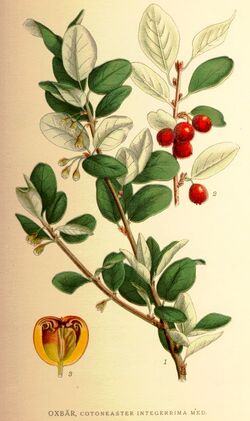Biology:Cotoneaster scandinavicus
| Cotoneaster scandinavicus | |
|---|---|

| |
| 1917 painting from Sweden | |
| Scientific classification | |
| Kingdom: | Plantae |
| Clade: | Tracheophytes |
| Clade: | Angiosperms |
| Clade: | Eudicots |
| Clade: | Rosids |
| Order: | Rosales |
| Family: | Rosaceae |
| Genus: | Cotoneaster |
| Species: | C. scandinavicus
|
| Binomial name | |
| Cotoneaster scandinavicus B.Hylmö
| |
Cotoneaster scandinavicus, commonly known as Scandinavian cotoneaster, is a species of Cotoneaster native to Scandinavia, in Norway , Sweden and Finland south of the Arctic Circle, the Denmark island of Bornholm, and also the Baltic States of Estonia and Latvia.[1][2]
It is a recently described species, closely related to (and formerly considered conspecific with) Cotoneaster integerrimus from central and eastern Europe and southwest Asia, and is also related to Cotoneaster cambricus from Wales. It differs from C. integerrimus in that the leaves are always glabrous above, and the 5 mm diameter fruit are light orange-red, not dark red. It grows up to 2 m (7 ft) tall (though usually much less), and occurs primarily on thin soils over chalk and limestone.[1]
References
- ↑ 1.0 1.1 Den virtuella floran: Cotoneaster scandinavicus (in Swedish)
- ↑ "Cotoneaster scandinavicus". Birds and Wildlife in Denmark. http://www.fugleognatur.dk/english/art2_uk.asp?mode=obs&ID=5299&common_name=Common%20Cotoneaster&scientific_namen=Cotoneaster%20scandinavicus. Retrieved August 21, 2007.[yes|permanent dead link|dead link}}]
Wikidata ☰ Q2712538 entry
 |

